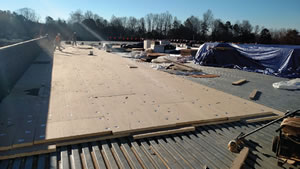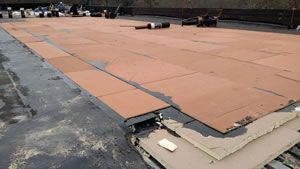Weather or Not?

PHOTO COURTESY OF NICK APERGIS
Simple Things
Whether it is annual, semi-annual or
monthly, most experts agree that inspections
by trained personnel will reduce leaks. Richard
Rast of Bluefin, LLC, in Denver, Colo.,
says, “One of the biggest ‘small’ things that
we run into is roof leaks related to clogged
roof drains, gutters and debris on the roof.”
He says these inspections, done by in-house
technicians or a local roofing contractor can
be used to identify little problems before
they become bigger problems: screws and
fasteners left by HVAC maintenance personnel,
open covers on roof-top mechanical
equipment, a quick check of flashing systems
and penetrations. “It’s simple, easy and inexpensive,
but well worth the investment of
time and resources. We find that this simple
activity reduces roof leaks in most cases by
more than 50 percent.”
Also, pay attention to how debris
are disposed of. The principal at the old
Sterling Elementary School in Charlotte,
N.C., complained of chronic water infiltration,
particularly in the fall. The school
is comprised of the original building and
multiple additions, forming three sides of a
large courtyard that sloped toward the later
additions. A visit to the school found that
leaf disposal amount to raking them all to
the low spot in the courtyard — the yard
drain. Once the leaves were removed, proper
drainage was restored.
While inspections are beneficial at any
time, Len Witke, the former head of facilities
for Cabarrus County Schools in North Carolina,
suggests his technicians often found
holes in a membrane by walking the roof a
day or so after a rain. Walking on the wet
insulation will often squirt water through
the holes in the roof membrane.
Accessibility
Although there are times when a green
roof, ballasted roof, or a roof-mounted solar
system is more desirable, the common
sense advice from the experts was that it is
easier to find the source of a problem if the
roof is visible and continuous.
When a passive solar, earth sheltered elementary school was designed and built
in a western rural community 20 years ago,
it was the pride of the region. When the
roof began leaking recently, it was an emergency.
The soil that covered the single-ply
membrane and the topsoil that drifted
behind the high parapet walls made repairs
unfeasible. Excavation and replacement
was the only option.
If a rake is used to distribute ballast,
the teeth always point up. Well, maybe not
always. One professional found that the
rake used to distribute the ballast on his
roof had put hundreds of tiny holes in the
membrane. The ballast was removed, the
membrane repaired, and mechanically
fastened so that any other holes could be
easily repaired as they were discovered.
Permanent roof access within the building
complete with stairs or a ladder is an
essential part of a good roof maintenance
plan since regular access is critical.
Preventative Maintenance
Emergency responses are the stuff of
nightmares for school facilities professionals.
To counter this, Witke says, “Funding a
preventative maintenance program for roofs
is absolutely necessary and will substantially
reduce the number of emergency responses.”
While it is still raining, there is little the
maintenance technicians can do. Attempting
to control the flow of water once it is in
the building sometimes feels like you are
rearranging the deck chairs on the Titanic.
Drying everything out once the rain is over,
is certainly necessary, but still not forward
progress toward a solution. Substantial water
intrusion disrupts classes and often mobilizes
angry parents.
Slow leaks are sometimes more difficult to investigate. One
of Witke’s elementary schools had a sloped roof that leaked just
enough water to rust the hangers and screws of the suspended drywall
ceiling. Since the water never stained the ceiling, the damage
was not discovered until a 4-inch x 8-inch panel collapsed one day,
narrowly missing a student.
Operating a national roof program management company,
Richard Rast advises that much can be accomplished with trained
in-house technicians and a proactive management of scheduled repairs.
“We find that many school districts manage roofs reactively.”
They only respond to emergencies when they occur, believing
falsely they are saving money by doing little or nothing to achieve
maximum service life if the roof isn’t leaking. Unfortunately, he
says, “The results are shortened roof life, poor roof reliability and
increased operating and capital costs.”
Rast believes the best opportunity to improve roof performance
and reduce costs is a balanced approach of preventive maintenance
and proactive management of repairs as defects are discovered.
This saves in two ways: (1) Repairs done on a timely basis reduce
leaks and related collateral expenses. It also prolongs serviceable
life, and reduces capital expense for roof replacement. (2) If all
needed repairs are identified for each building in the inventory
and purchased in bulk, the unit price for each repair drops by 70
percent or more because it is more efficient for the contractor to do
a larger amount of work on a schedule vs. running single repairs
as a service call. He concludes, “This impacts both operating
and capital budgets. Identification and documentation of needed
repairs can either be done in-house or using a consultant.”
Occupant Sensitivity

PHOTO COURTESY OF NICK APERGIS
Identifying issues is much easier during installation (whether it is builtup
or single-ply) than when the roof leaks after the fact.
Often, built up roofing on schools was performed in the summer
to avoid subjecting the teachers and students to the fumes.
Adhesives today present similar problems to the use of hot roofing
material in the past. If the roofing is done while the building is in
use, occupants often complain of noxious odors. Occupied buildings
may present other problems as well.
An elementary school near Annapolis, Md., had a single-ply roof
being mechanically attached through the tectum roof deck during
the school year. As the temperature rose during the day, the students
and teachers noticed not only the odor of tar, but also black spots beginning
to appear on the ceiling tiles. It seems that the built-up roof
underneath the new rubber membrane was liquefied by the heat and
was dripping through the holes in the deck. That summer, a fully
adhered membrane was installed once a total tear-off was completed
and all of the holes in the tectum were sealed.
Just as there is no substitute for a roof that is properly installed,
there is no substitute for roof repairs that are timely and appropriate.
Much of leak prevention is common sense: knowing the material
and its’ idiosyncrasies, knowing how it performs in your local
weather conditions, inspecting regularly relying on documentation
and not institutional memory to clear debris, and looking for
possible problems, not waiting for them to occur.
There is no perfect roof. As Clayton Dekle said, it’s about
WHEN, not IF it will fail.
This article originally appeared in the issue of .
About the Authors
Mike Raible is founder and CEO of The School Solutions Group in Charlotte, N.C., and the author of "Every Child, Every Day: Achieving Zero Dropouts Through Performance-Based Education". He can be reached at [email protected].
Andrew LaRowe is president of EduCon Educational Consulting located in Winston Salem, N.C. He can be reached at [email protected]